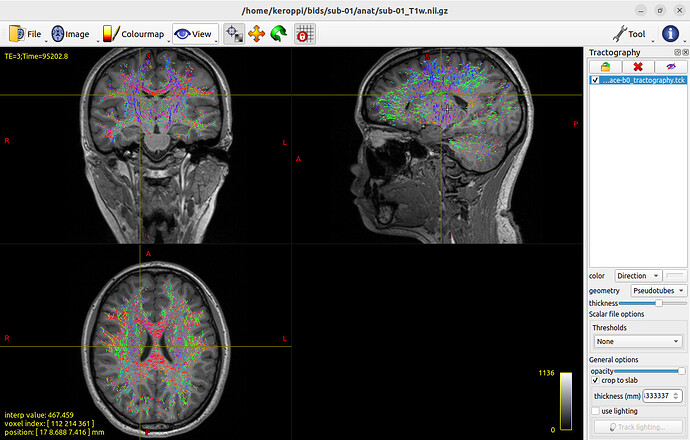My suggestion of using SS3T-CSD instead of MSMT-CSD for single shell data comes from Single-Shell 3-Tissue CSD | MRtrix3Tissue(Single-Shell 3-Tissue CSD (SS3T-CSD) | MRtrix3Tissue) and the discussion in Single shell vs. “Single tissue” - #5 by araikes)"
I especially note": [quote=“araikes, post:7, topic:5761”]
In the tutorial for the single tissue CSD (https://mrtrix.readthedocs.io/en/3.0.3/fixel_based_analysis/st_fibre_density_cross-section.html) uses dwi2response tournier and then states the following:
When performing fixel-based analysis, constrained spherical deconvolution (CSD) should be performed using the unique (average) white matter response function obtained before. Note that dwi2fod csd can be used, however here we use dwi2fod msmt_csd (even with single shell data) to benefit from the hard non-negativity constraint, which has been observed to lead to more robust outcomes
[/quote]
Were Thijs states:
Ah yes, that is true. I’d already forgotten about that. This is something I once also advocated for, but my experiences on that have become more mixed in recent years. The reasons for that are more complicated; and since the forced moderation of my posts, I don’t think I’ve shared that in any recent times here. I personally wouldn’t always use the “hard-constrained” version (i.e. the MSMT-CSD code, but within the single-tissue pipeline as you linked to above) for a single-tissue scenario anymore; it lacks an amount of flexibility that can be surprisingly relevant for certain specific applications or contexts.
However, that would indeed still be a single-tissue approach (i.e. fitting everything as if it were WM only); something which itself is arguably no longer necessary in any scenario. That said, I can now also better appreciate your possible confusion when you saw MSMT-CSD in the single-tissue FBA pipeline.
But to indeed be 100% clear: I don’t consider the above to be necessary anymore regardless. Put differently: the whole “single-tissue” FBA pipeline, I would strongly advice, should no longer be used. With the availability of both MSMT-CSD and SS3T-CSD, it’s always possible to use 3 tissues (WM/GM/CSF) with the “multi-tissue” FBA pipeline. In some exceptionally challenging or problematic scenarios (we’re talking combinations of non-human, ex-vivo and/or before birth here; or very unfavourable acquisitions), this could be limited to 2 tissues, often WM and CSF/fluid. But even in those scenarios, some manual work in getting the right response functions can overcome that (though you’ll need some technical expertise there to dig in). But to be clear also on this point: the necessity of the latter is extremely exceptional. Long story short: 3-tissue modelling, be it with MSMT-CSD or SS3T-CSD is almost always possible, and I would strongly advise to use always use the “multi-tissue” FBA pipeline, combined with the appropriate CSD technique. That’s the pipeline we also described in the review paper: regardless of single-shell (+b=0) or multi-shell data, the pipeline is always “multi-tissue”, allowing for the use of the best methods throughout. If it were up to me, I’d remove the single-tissue FBA pipeline from the online manual at this stage, or at least don’t link it directly from the main menu. It only tends to confuse people unnecessarily."
See also, https://www.sciencedirect.com/science/article/pii/S1053811921006923?via%3Dihub
@bjeurissen, is this now incorporated in MSMT-CSD, or is Thijs’s recommendation outdated?
